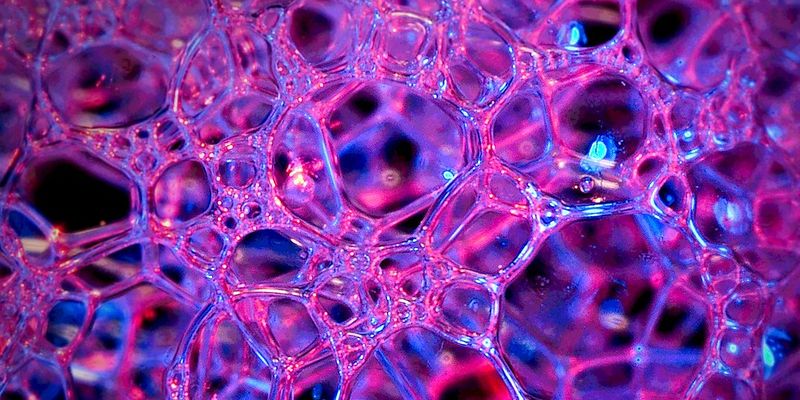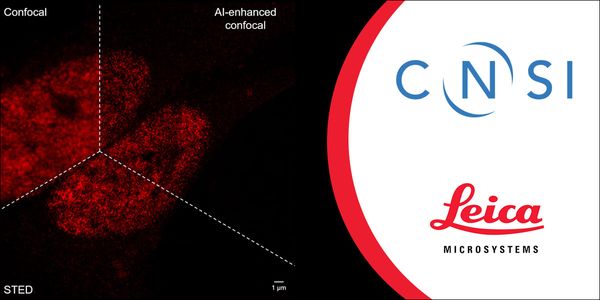Neural Network
Neural Network is a network or circuit of neurons, or in a modern sense, an artificial neural network that is composed of artificial neurons or nodes which are designed to recognize patterns.
-
MAR 11, 2020 | 3:00 PMIdentifying the diversity of neuronal cell types of the nervous system is one of the main objectives of the BRAIN Initiative, with the vision that distinct neuronal identities will allow for...Speaker: Giorgio Ascoli, PhD , Hong-Wei Dong, MD, PhD , Byungkook Lim, PhDPresented at: Neuroscience Virtual Event Series 2020
MAR 11, 2020 | 12:00 PMMechanistic understanding of neural systems is daunting to achieve in large part due to the heterogeneity of the neuronal elements in both form and function and the complexity of the circuit...Speaker: Emre Aksay, PhD , Mark Goldman, PhD , Sebastian Seung, PhD , Ashwin Vishwanathan, PhDPresented at: Neuroscience Virtual Event Series 2020
MAR 11, 2020 | 10:30 AMThe neural basis of simple rhythmic and reflexive behaviors such as swimming and gill withdrawal have been successfully studied in nudibranchs and other gastropod molluscs because the brains...Speaker: Paul Katz, PhD , Jeff Lichtman, MD, PhD , William Frost, PhD , Deidre Lyons, PhD , Vince Lyzinski, PhD, B.Sc, M.Sc, M.Sc.E.Presented at: Neuroscience Virtual Event Series 2020
MAR 11, 2020 | 9:00 AMAlthough neuroscience has provided a great deal of information about how neurons work, the fundamental question of how neurons function together in a network to produce cognition has been di...Speaker: György Buzsáki, PhD , Attila Losonczy , Mark Schnitzer , Ivan SolteszPresented at: Neuroscience Virtual Event Series 2020
JAN 01, 2020 | 6:00 AMIn Andalman et al, 2018, we explored the activity of over 10,000 neurons across more than 15 regions imaged simultaneously in larval zebrafish in a novel behavioral challenge paradigm. Compl...SEP 11, 2019 | 1:30 PMBackground: The vast majority of all genes are contained within the genomes of the prokaryotes, including the eubacteria and the archaea. These largely single-cellular domains of life thus...Speaker: Garth Ehrlich, PhD, FAAASAPR 18, 2019 | 9:00 AMDATE: April 18, 2019 TIME: 9:00am PDT...Speaker: Aydogan Ozcan, PhD , Hongda Wang, MS, BS , Yair Rivenson, PhD , Laurent Bentolila, PhDSponsored By: Leica MicrosystemsMAR 13, 2019 | 2:20 PMPlasticity in the brain is very extensive due to the brain’s parallel architecture and synaptic reorganization capabilities. Because neuronal populations are typically in stable low e...MAR 13, 2019 | 2:00 PMActions are not mediated solely by cortical processes but rely on communication within basal ganglia-thalamocortical loops. Speech is one example, although how the basal ganglia participate i...MAR 13, 2019 | 1:40 PMDeep brain stimulation (DBS) represents one of the major clinical breakthroughs in the age of translational neuroscience. In 1987, Benabid and colleagues demonstrated that high-frequency stim...MAR 13, 2019 | 1:00 PMLocalizing and identifying neuronal patterns that generate pathological brain signals may assist with tissue resection and intervention strategies in patients with neurological and psychiatri...MAR 13, 2019 | 8:40 AMHumans have a remarkable ability to flexibly interact with the environment. A compelling demonstration of this cognitive flexibility is our ability to perform complex, yet previously un-pract...MAR 13, 2019 | 7:40 AMThe human brain has a remarkable ability to store and retrieve information. Detailed memories can be formed after as little as one exposure, and those memories can be retained for decades. Im...FEB 14, 2019 | 10:30 AMThis presentation will discuss and review the promise and potential of 3D Microtissues, and the challenges of using these Microtissues as Hazard ID tools. Lastly, we will discuss the potentia...NOV 15, 2018 | 10:00 AMThe complexity of the human brain, with thousands of neuronal types, permits the development of sophisticated behavioral repertoires, such as language, tool use, self-awareness, symbolic thou...MAR 15, 2018 | 10:30 AMIn consciousness studies, a longstanding controversy concerns whether activity in the prefrontal cortical (PFC) region of the brain is necessary to evoke conscious experiences. Similarly, the...MAR 15, 2018 | 9:00 AMThe inability of neurons to regenerate damaged axons within the CNS has dire consequences for victims of traumatic or ischemic brain injury and multiple neurodegenerative diseases. Like other...MAR 14, 2018 | 7:30 AMThe cerebellum is incorporated into the distributed neural circuits subserving motor control, cognitive processing and the modulation of emotion. This lecture provides an overview of anatomic...MAR 14, 2018 | 6:00 AMPsychiatric diagnosis is inherently difficult, due to the lack of clear biomarkers or any other objective assessment. Although quantitative, the psychometric scales employed during the psychi...FEB 28, 2018 | 12:00 AMTBD...NOV 16, 2017 | 10:00 AMDATE: November 16, 2017TIME: 10:00am PST, 1:00pm EST, Neuronal networks play a fundamental role in the brain, with many diseases linked to disruptions in network activity. Cell-ba...NOV 09, 2017 | 12:00 PMA panel of experts will discuss recent advances and current challenges for the successful development and application of human tissue for drug screening, tissue replacement and eventually org...Speaker: Nina Tandon , Benjamin ShepherdPresented at: 5th annual 24 Hours of Stem Cells™ virtual event
MAY 25, 2017 | 12:00 PMDiseases like cancer have complex tissue morphology requiring microscopic examination. Typically this involves 2D examination through a microscope by a pathologist, a slow and manual pr...MAY 11, 2017 | 6:00 AMBoston Children’s Hospital is developing the infrastructure needed for large-scale psychiatric research and treatment discovery. The Manton Center for Orphan Disease Research and...
MAR 11, 2020 | 3:00 PM
Identifying the diversity of neuronal cell types of the nervous system is one of the main objectives of the BRAIN Initiative, with the vision that distinct neuronal identities will allow for...
Speaker:
Giorgio Ascoli, PhD
, Hong-Wei Dong, MD, PhD
, Byungkook Lim, PhD
Presented at: Neuroscience Virtual Event Series 2020
MAR 11, 2020 | 12:00 PM
Mechanistic understanding of neural systems is daunting to achieve in large part due to the heterogeneity of the neuronal elements in both form and function and the complexity of the circuit...
Speaker:
Emre Aksay, PhD
, Mark Goldman, PhD
, Sebastian Seung, PhD
, Ashwin Vishwanathan, PhD
Presented at: Neuroscience Virtual Event Series 2020
MAR 11, 2020 | 10:30 AM
The neural basis of simple rhythmic and reflexive behaviors such as swimming and gill withdrawal have been successfully studied in nudibranchs and other gastropod molluscs because the brains...
Speaker:
Paul Katz, PhD
, Jeff Lichtman, MD, PhD
, William Frost, PhD
, Deidre Lyons, PhD
, Vince Lyzinski, PhD, B.Sc, M.Sc, M.Sc.E.
Presented at: Neuroscience Virtual Event Series 2020
MAR 11, 2020 | 9:00 AM
Although neuroscience has provided a great deal of information about how neurons work, the fundamental question of how neurons function together in a network to produce cognition has been di...
Speaker:
György Buzsáki, PhD
, Attila Losonczy
, Mark Schnitzer
, Ivan Soltesz
Presented at: Neuroscience Virtual Event Series 2020
JAN 01, 2020 | 6:00 AM
In Andalman et al, 2018, we explored the activity of over 10,000 neurons across more than 15 regions imaged simultaneously in larval zebrafish in a novel behavioral challenge paradigm. Compl...
SEP 11, 2019 | 1:30 PM
Background: The vast majority of all genes are contained within the genomes of the prokaryotes, including the eubacteria and the archaea. These largely single-cellular domains of life thus...
Speaker:
Garth Ehrlich, PhD, FAAAS
APR 18, 2019 | 9:00 AM
DATE: April 18, 2019 TIME: 9:00am PDT...
Speaker:
Aydogan Ozcan, PhD
, Hongda Wang, MS, BS
, Yair Rivenson, PhD
, Laurent Bentolila, PhD
Sponsored By: Leica Microsystems
MAR 13, 2019 | 2:20 PM
Plasticity in the brain is very extensive due to the brain’s parallel architecture and synaptic reorganization capabilities. Because neuronal populations are typically in stable low e...
MAR 13, 2019 | 2:00 PM
Actions are not mediated solely by cortical processes but rely on communication within basal ganglia-thalamocortical loops. Speech is one example, although how the basal ganglia participate i...
MAR 13, 2019 | 1:40 PM
Deep brain stimulation (DBS) represents one of the major clinical breakthroughs in the age of translational neuroscience. In 1987, Benabid and colleagues demonstrated that high-frequency stim...
MAR 13, 2019 | 1:00 PM
Localizing and identifying neuronal patterns that generate pathological brain signals may assist with tissue resection and intervention strategies in patients with neurological and psychiatri...
MAR 13, 2019 | 8:40 AM
Humans have a remarkable ability to flexibly interact with the environment. A compelling demonstration of this cognitive flexibility is our ability to perform complex, yet previously un-pract...
MAR 13, 2019 | 7:40 AM
The human brain has a remarkable ability to store and retrieve information. Detailed memories can be formed after as little as one exposure, and those memories can be retained for decades. Im...
FEB 14, 2019 | 10:30 AM
This presentation will discuss and review the promise and potential of 3D Microtissues, and the challenges of using these Microtissues as Hazard ID tools. Lastly, we will discuss the potentia...
NOV 15, 2018 | 10:00 AM
The complexity of the human brain, with thousands of neuronal types, permits the development of sophisticated behavioral repertoires, such as language, tool use, self-awareness, symbolic thou...
MAR 15, 2018 | 10:30 AM
In consciousness studies, a longstanding controversy concerns whether activity in the prefrontal cortical (PFC) region of the brain is necessary to evoke conscious experiences. Similarly, the...
MAR 15, 2018 | 9:00 AM
The inability of neurons to regenerate damaged axons within the CNS has dire consequences for victims of traumatic or ischemic brain injury and multiple neurodegenerative diseases. Like other...
MAR 14, 2018 | 7:30 AM
The cerebellum is incorporated into the distributed neural circuits subserving motor control, cognitive processing and the modulation of emotion. This lecture provides an overview of anatomic...
MAR 14, 2018 | 6:00 AM
Psychiatric diagnosis is inherently difficult, due to the lack of clear biomarkers or any other objective assessment. Although quantitative, the psychometric scales employed during the psychi...
FEB 28, 2018 | 12:00 AM
TBD...
NOV 16, 2017 | 10:00 AM
DATE: November 16, 2017TIME: 10:00am PST, 1:00pm EST, Neuronal networks play a fundamental role in the brain, with many diseases linked to disruptions in network activity. Cell-ba...
NOV 09, 2017 | 12:00 PM
A panel of experts will discuss recent advances and current challenges for the successful development and application of human tissue for drug screening, tissue replacement and eventually org...
Speaker:
Nina Tandon
, Benjamin Shepherd
Presented at: 5th annual 24 Hours of Stem Cells™ virtual event
MAY 25, 2017 | 12:00 PM
Diseases like cancer have complex tissue morphology requiring microscopic examination. Typically this involves 2D examination through a microscope by a pathologist, a slow and manual pr...
MAY 11, 2017 | 6:00 AM
Boston Children’s Hospital is developing the infrastructure needed for large-scale psychiatric research and treatment discovery. The Manton Center for Orphan Disease Research and...
























